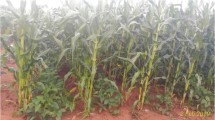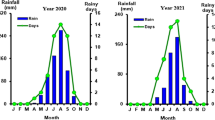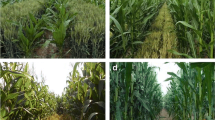Abstract
Intercropping cotton (Gossypium hirsutum L.) and cowpea (Vigna unguiculata (L.) Walp) is one of the ways to improve food security and soil fertility whilst generating cash income of the rural poor. A study was carried out to find out the effect of cotton–cowpea intercropping on cowpea N2-fixation capacity, nitrogen balance and yield of a subsequent maize crop. Results showed that cowpea suppressed cotton yields but the reduction in yield was compensated for by cowpea grain yield. Cowpea grain yield was significantly different across treatments and the yields were as follows: sole cowpea (1.6 Mg ha−1), 1:1 intercrop (1.1 Mg ha−1), and 2:1 intercrop (0.7 Mg ha−1). Cotton lint yield was also significantly different across treatments and was sole cotton (2.5 Mg ha−1), 1:1 intercrop (0.9 Mg ha−1) and 2:1 intercrop (1.5 Mg ha−1). Intercropping cotton and cowpea increased the productivity with land equivalence ratios (LER) of 1.4 and 1.3 for 1:1 and 2:1 intercrop treatments, respectively. There was an increase in percentage of N fixation (%Ndfa) by cowpea in intercrops as compared to sole crops though the absolute amount fixed (Ndfa) was lower due to reduced plant population. Sole cowpea had %Ndfa of 73%, 1:1 intercrop had 85% and 2:1 intercrop had 77% while Ndfa was 138 kg ha−1 for sole cowpea, 128 kg ha−1 for 1:1 intercrop and 68 kg ha−1 for 2:1 intercrop and these were significantly different. Sole cowpea and the intercrops all showed positive N balances of 92 kg ha−1 for sole cowpea and 1:1 intercrop, and 48 kg ha−1 for 2:1 intercrop. Cowpea fixed N transferred to the companion cotton crop was very low with 1:1 intercrop recording 3.5 kg N ha−1 and 2:1 intercrop recording 0.5 kg N ha−1. Crop residues from intercrops and sole cowpea increased maize yields more than residues from sole cotton. Maize grain yield was, after sole cotton (1.4 Mg ha−1), sole cowpea (4.6 Mg ha−1), 1:1 intercrops (4.4 Mg ha−1) and 2:1 intercrops (3.9 Mg ha−1) and these were significantly different from each other. The LER, crop yields, %N fixation and, N balance and residual fertility showed that cotton–cowpea intercropping could be a potentially productive system that can easily fit into the current smallholder farming systems under rain-fed conditions. The fertilizer equivalency values show that substantial benefits do accrue and effort should be directed at maximizing the dry matter yield of the legume in the intercrop system while maintaining or improving the economic yield of the companion cash crop.
Similar content being viewed by others
References
Brady NC (1990) The nature and property of soils, 10th edn. MacMillan Publishing Company, New York
Bremner JM, Mulvaney CS (1982) Nitrogen – total. In: Page AL, Miller RH, Keeney DR (eds) Methods of Soil Analysis, Part 2. Agronomy 9, 2nd edn. ASSA, Madison, WI, USA. pp 595–622
Cadisch G, Giller KE (eds) (1997) Driven by nature: plant residue quality and decomposition. CAB International, Wallingford, UK, 409 pp
Cooper GRC, Fenner RJ (1981) General fertilizer recommendations. Zimbabwe Agric J 78:123–128
Cotton Research Institute (1996) Annual report 1993/1994. Department of Research and Specialist Services, Harare, Zimbabwe, 274 pp
Cotton Training Center (2000) Zimbabwe cotton handbook. Kadoma, Zimbabwe, 151 pp
De Wit CT, Van den Bergh JP (1965) Competition between herbage plants. Neth J Agric Sci 13:212–221
Eaglesham ARJ, Minchin FR, Summerfield RJ, Dart PJ, Huxley PA, Day JM (1977) Nitrogen nutrition of cowpea (Vigna unguiculata). III. Distribution of nitrogen within effectively nodulated plants. Exp Agric 13:369–380
Fukai S, Trenbath BR (1993) Processes determining intercrop productivity and yields of component crops. Field Crops Res 34:247–271
Genstat (2002) Release 6.1, VSN International Ltd., Oxford, UK
Giller KE (2001a) Nitrogen fixation in tropical cropping systems, 2nd edn. CAB International, Wallingford, UK, 423 pp
Giller KE (2001b) Targeting management of organic resources and mineral fertilizers: can we match scientists’ fantasies with farmers’ realities? In: Vanlauwe B, Sanginga N, Diels J, Merckx R (eds) Balanced nutrient management systems for moist savanna and humid forest zones of Africa. CAB International, Wallingford, UK
Giller KE, Witty JF (1987) Immobilized 15N-fertilizer sources improve the accuracy of field estimates of N2-fixation by isotope dilution. Soil Biol Biochem 19:459–463
Hardy RWF (1993) Biological nitrogen fertilization: present and future applications. In: Srivastava JP, Aldermans H (eds) Agriculture and environmental challenges. Proc 13th Agric. Sector Symp. The World Bank, Washington, DC, pp 109–117
Heaton THE, Spiro B, Madeline S, Robertson C (1997) Potential canopy influences on isotopic composition of nitrogen and sulphur in atmospheric deposition. Oecologia 109:600–607
He XH, Critchley C, Bledsoe C (2003) Nitrogen transfer within and between plants through common mycorrhizal networks (CMNs). Crit Rev Plant Sci 22(6):531–567
Jensen ES, Høgh-Jensen H, Jørgensen FV, Schjørring JK, Vinther FP (1997) Management of biological nitrogen fixation in grass/clover leys. In: Kristensen NH, Høgh-Jensen H (eds) New research in organic agriculture. IFOAM, Tholey-Theley. pp 89–96
Jeranyama P, Hestermann OB, Waddington SR, Harwood RR (2000) Relay intercropping of sunnhemp and cowpea into a smallholder maize system in Zimbabwe. Agron J 92:239–244
Jeranyama P, Hesterman OB, Waddington SR (1998) The impact of legumes relay intercropped into maize at Domboshava, Zimbabwe. In: Waddington SR, Murwira HK, Kumwenda JDT, Hikwa D, Tagwira F (eds) Soil fertility research for maize-based farming systems in Malawi and Zimbabwe. Proceedings of the Soil Fertility Network results and planning workshop, 7–11 July 1997, Mutare, Zimbabwe. Soil Fert Net and CIMMYT-Zimbabwe, Harare, Zimbabwe, pp 31–34
Kurdali F, Domenach AM, Bardin R (1990) Alder–poplar associations: determination of nitrogen sources by isotope techniques. Biol Fertil Soils 9:321–329
Marschner H (1995) Mineral nutrition of higher plants. 2nd edn. Academic Press. Muenchen, 889 pp
Mashiringwani NA (1983) The present nutrient status of the soils in the communal farming areas of Zimbabwe. Zimbabwe Agric J 80:73–75
McAulife C, Chamblee DS, Uribe-Arango H, Woodhouse WW Jr (1958) Influence of inorganic nitrogen on nitrogen fixation by legumes as revealed by 15N. Agron J 50:334–337
McNeill AM, Pilbeam CJ, Harris HC, Swift RS (1996) Seasonal variation in the suitability of different methods for estimating biological nitrogen fixation by grain legumes under rain-fed conditions. Aust J Agric Res 47:10661–10673
Miller R (1998) Legume cover crops for northern California, Small Farm Center, UC Coop. EXT. UC Davis
Monks CD (1999) Cotton morphology, physiology, fruiting and development. In: W Foshee, BL Freeman, CD Monks, MG Patterson, RH Smith (eds) Cotton scouting handbook. ANR−409, Auburn University
Myaka FA, Kabissa JCB (1996) Fitting short duration cowpea into a cotton-based cropping system in Tanzania: effect of planting pattern, time of planting cowpea and insecticide application to cotton. Exp Agric 32:225–230
Mutuo PK, Marandu AE, Rabeson R, Mwale M, Snapp S, Palm CA (1999) Nitrogen fertilizer equivalencies based on organic input quality and optimum combinations of organic and inorganic N sources. SWNM Report on combating Nutrient Depletion – East Africa Highlands consortium
Nyamapfene KW (1991) Soils of Zimbabwe. Nehanda Publishers (Pvt) Ltd., Harare, Zimbabwe, pp 75–79
Peoples MB, Bowman AM, Gault RR, Herridge DF, McCallum M, McCormick KM, Norton RM, Rochester IJ, Scammell GJ, Schwenke GD (2001) Factors regulating the contributions of fixed nitrogen by pasture and crop legumes to different farming systems of eastern Australia. Plant Soil 228:29–41
Peoples MB, Lilley DM, Brett VF, Ridley AM, Garden DL (1995) Effects of surface applications of lime and superphosphate to acid soils on the growth and N2 fixation by subterranean clover in mixed pasture swards. Soil Biol Biochem 27:663–671
Rao MR, Rego TJ, Willey RW (1987) Response of cereals to nitrogen in sole cropping and intercropping with different legumes. Plant Soil 101:167–177
Rao MR, Mathuva MN (2000) Legumes for improving maize yields and income in semi-arid Kenya. Agric Ecosyst Environ 78:123–137
Reddy KC, Visser PL, Klaij MC, Renard C (1994) The effects of sole and traditional intercropping of millet and cowpea on soil and crop productivity. Exp Agric 30:83–88
Reid MG (1977) The early agriculture of Matebeleland and Mashonaland. Rhodesia Agric J 74:97–102
Rochester IJ, Peoples MB, Constable GA, Gault RR (1998) Faba beans and other legumes add nitrogen to irrigated cotton cropping systems. Aust J Exp Agric 38:253–260
Russell CA, Fillery IRP (1996) Estimates of lupin below-ground biomass nitrogen, dry matter and nitrogen turnover to wheat. Aust J Agric Res 47:1047–1059
Snoeck D, Zapata F, Domenach AM (2000) Isotopic evidence of the transfer of nitrogen fixed by legumes to coffee trees. Biotechnol Agron Soc Environ 4(2):95–100
Sullivan P (1998) Intercropping principles and production practices. Appropriate Technology Transfer for Rural Areas (ATTRA), Fayetteville, AR
Thompson JG, Purves WD (1978) A guide to the soils of Rhodesia. Rhodesia Agriculture Journal Technical Handbook No. 3
Tjepkema JD, Schwintzer CR, Burris RH, Johnson GV, Silvester WB (2000) Natural abundance of 15N in actinorhizal plants and nodules. Plant Soil 219:285–289
Unkovich MJ, Pate JS (2000) An appraisal of recent field measurements of symbiotic N2 fixation by annual legumes. Fields Crop Res 65:211–228
van Kessel C, Hartley H. (2000) Agricultural management of grain legumes: has it led to an increase in nitrogen fixation? Field Crops Res 65:165–181
Vanlauwe B, Diels J, Sanginga N, Carsky RJ, Deckers J, Merckx R (2000) Utilization of rock phosphate by crops on a representative toposequence in the northern Guinea savanna zone of Nigeria: response by maize to previous herbaceous legume cropping and rock phosphate treatments. Soil Biol Biochem 32:2079–2090
Acknowledgements
Special thanks to N. Mutasa and R. Dhliwayo from Kadoma Cotton Research Institute’s Crop Productivity Unit for letting me use their land and assistance with laying out the trials especially during the first season. Financial support from TSBF-CIAT through the IFAD Project is greatly appreciated.
Author information
Authors and Affiliations
Corresponding author
Rights and permissions
About this article
Cite this article
Rusinamhodzi, L., Murwira, H.K. & Nyamangara, J. Cotton–cowpea intercropping and its N2 fixation capacity improves yield of a subsequent maize crop under Zimbabwean rain-fed conditions. Plant Soil 287, 327–336 (2006). https://doi.org/10.1007/s11104-006-9080-9
Received:
Accepted:
Published:
Issue Date:
DOI: https://doi.org/10.1007/s11104-006-9080-9




